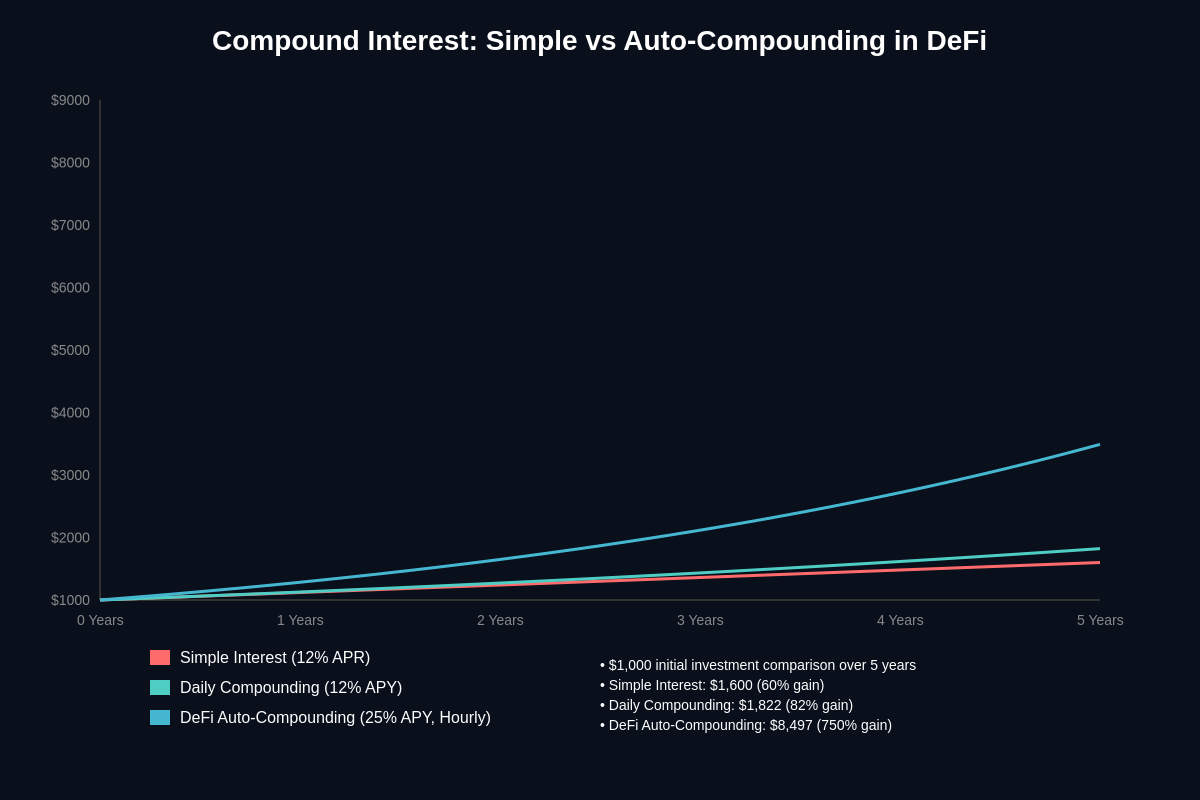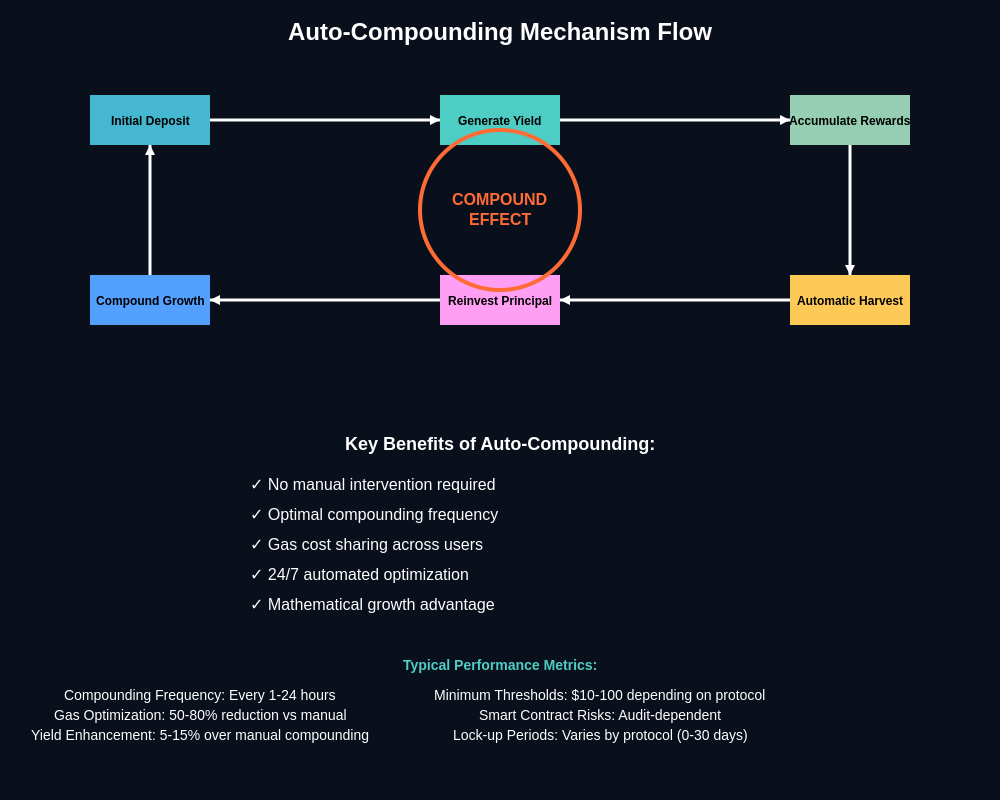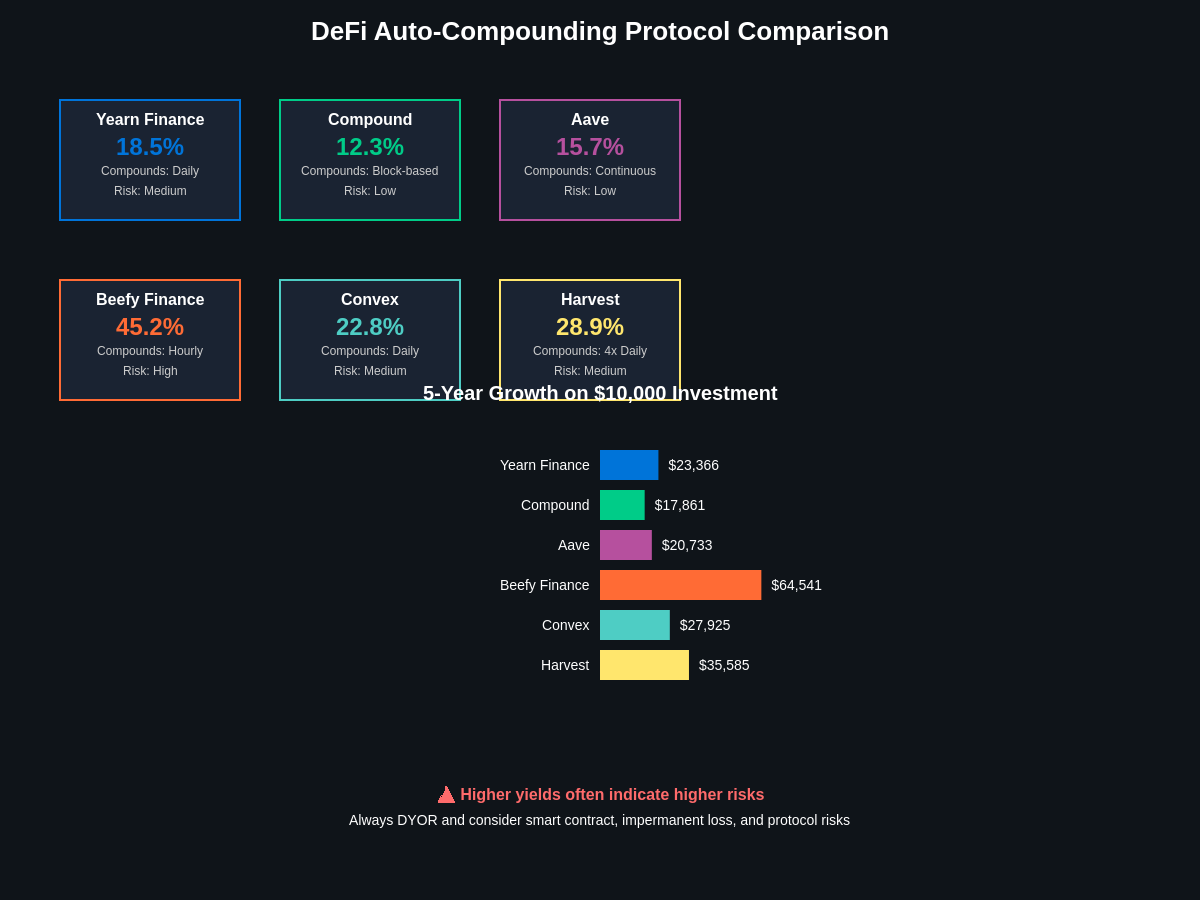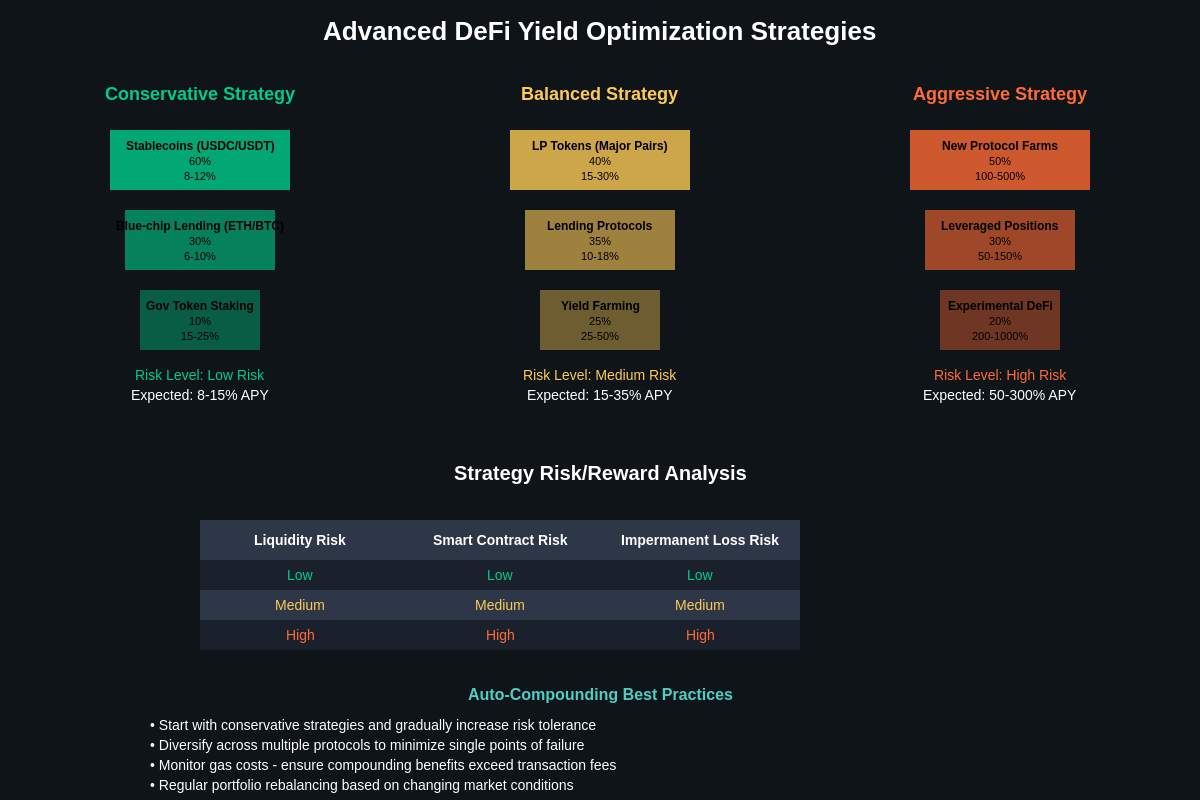Explore advanced DeFi strategies and yield optimization techniques
The Mathematical Magic of Compound Interest in Decentralized Finance
Compound interest represents one of the most powerful forces in traditional finance, and its application within decentralized finance protocols has created unprecedented opportunities for cryptocurrency holders to generate passive income through automated yield optimization strategies. The concept of auto-compounding in DeFi takes this fundamental financial principle and enhances it through smart contract automation, eliminating the need for manual reinvestment while maximizing returns through continuous compounding cycles that can occur multiple times per day rather than the traditional annual or quarterly intervals found in conventional finance.

The mathematical foundation of compound interest becomes significantly more potent in the DeFi ecosystem where yields can be substantially higher than traditional financial products and compounding frequencies can be dramatically increased through automated protocols. Unlike traditional savings accounts that might compound monthly or quarterly, DeFi auto-compounding protocols can reinvest rewards every few minutes or hours, creating a compounding effect that can dramatically amplify returns over time through the exponential growth curve that compound interest creates.
The power of compound interest in DeFi is further amplified by the ability to combine multiple yield-generating strategies within a single protocol, allowing users to benefit from staking rewards, liquidity provider fees, trading fees, and governance token distributions simultaneously. This multi-layered approach to yield generation creates complex compounding scenarios where returns from one source are automatically reinvested to generate additional returns from multiple sources, creating a synergistic effect that can significantly outperform simple linear yield strategies.
Understanding Auto-Compounding Mechanisms in DeFi Protocols
Auto-compounding mechanisms in DeFi protocols represent sophisticated smart contract systems designed to automatically harvest and reinvest rewards without requiring user intervention, thereby maximizing the compound interest effect through continuous reinvestment cycles. These protocols typically monitor user positions continuously and execute reinvestment transactions when certain conditions are met, such as when accumulated rewards reach a minimum threshold or when gas costs are optimized for maximum efficiency.

The technical implementation of auto-compounding varies significantly across different DeFi protocols, with some using simple reinvestment strategies that compound a single type of reward while others employ complex multi-token strategies that optimize across multiple yield sources. Advanced auto-compounding protocols incorporate sophisticated algorithms that consider factors such as gas costs, slippage, impermanent loss, and market conditions when determining optimal reinvestment timing and strategies.
Smart contract automation eliminates the manual effort and transaction costs associated with regular compounding while ensuring that compounding occurs at optimal intervals to maximize returns. The frequency of compounding in automated protocols can range from every block to daily cycles, depending on the protocol design and economic incentives built into the system. Higher frequency compounding generally results in better returns but must be balanced against the gas costs required to execute reinvestment transactions.
The gas optimization strategies employed by auto-compounding protocols represent a critical component of their effectiveness, as excessive transaction fees can significantly erode the benefits of frequent compounding. Many protocols implement batching mechanisms that combine multiple user transactions into single operations, distribute gas costs across multiple users, or utilize layer-two solutions to reduce transaction costs while maintaining high compounding frequencies.
Yield Farming and Liquidity Mining Strategies
Yield farming represents one of the most popular applications of compound interest principles in DeFi, where users provide liquidity to various protocols in exchange for rewards that can be automatically compounded to increase their overall returns. Monitor yield farming opportunities across different protocols to identify the most attractive compounding opportunities in the current market environment.

The complexity of modern yield farming strategies extends far beyond simple token deposits, incorporating multi-protocol strategies that optimize returns across different platforms while managing risks through diversification and automated rebalancing. Advanced yield farmers utilize sophisticated protocols that automatically move funds between different opportunities based on changing yield rates, protocol risks, and market conditions, creating dynamic strategies that adapt to evolving market conditions.
Liquidity mining programs often provide additional layers of rewards beyond basic trading fees, including governance tokens, platform-specific rewards, and bonus incentives that can be automatically compounded alongside base yields. The compound effect of these multiple reward streams can create extraordinarily high annual percentage yields, particularly during protocol launch phases or when platforms are competing for liquidity through aggressive incentive programs.
The temporal aspects of yield farming rewards present unique opportunities for compound interest optimization, as many protocols distribute rewards continuously rather than in discrete payments. This constant reward accrual means that auto-compounding protocols can reinvest rewards almost immediately, maximizing the time that newly earned tokens spend generating additional returns through the compound interest effect.
Risk management in yield farming requires careful consideration of various factors including smart contract risks, impermanent loss potential, token price volatility, and protocol sustainability. Effective auto-compounding strategies incorporate risk assessment mechanisms that balance potential returns against associated risks while maintaining diversification across multiple protocols and asset types to minimize exposure to any single point of failure.
Advanced Compounding Strategies and Protocol Combinations
Advanced DeFi users employ sophisticated strategies that combine multiple protocols and compounding mechanisms to create complex yield optimization systems that can generate returns significantly higher than single-protocol approaches. These strategies often involve utilizing multiple DeFi primitives simultaneously, such as lending, borrowing, liquidity providing, and staking within interconnected systems that amplify compound interest effects through leverage and cross-protocol yield optimization.

Protocol combination strategies leverage the composability of DeFi systems to create yield-generating loops where returns from one protocol are automatically reinvested into complementary protocols that provide additional yield sources. For example, users might deposit assets into a lending protocol to earn yield, borrow against those assets to provide liquidity in automated market makers, and stake the resulting LP tokens in additional farming protocols, creating multiple compounding streams from a single initial deposit.
Leveraged yield farming represents an advanced strategy where users borrow additional capital to increase their exposure to yield-generating opportunities, amplifying both potential returns and risks through the leverage effect. When combined with auto-compounding mechanisms, leveraged positions can generate extremely high returns through the mathematical amplification of compound interest, though they also introduce additional risks including liquidation potential and increased exposure to protocol failures.
Cross-chain yield optimization strategies utilize bridges and multi-chain protocols to access yield opportunities across different blockchain networks, allowing users to benefit from varying yield rates and protocol incentives across different ecosystems. Auto-compounding mechanisms in cross-chain strategies must account for bridge fees, transaction costs across different networks, and the additional complexity of managing positions across multiple blockchain environments.
The integration of derivatives and synthetic assets into compounding strategies creates additional opportunities for yield optimization while introducing new risk factors that must be carefully managed. Users can utilize options protocols, perpetual swaps, and synthetic asset platforms to create hedged positions that benefit from compound interest while minimizing exposure to adverse price movements in underlying assets.
Risk Assessment and Mitigation in Auto-Compounding
Risk assessment in DeFi auto-compounding requires comprehensive evaluation of multiple risk factors including smart contract vulnerabilities, protocol governance risks, token economic sustainability, and broader market risks that can affect the viability of compounding strategies. Unlike traditional financial products where risks are often well-understood and regulated, DeFi protocols present novel risk profiles that require careful analysis and ongoing monitoring.
Smart contract risks represent perhaps the most significant concern for auto-compounding users, as vulnerabilities in protocol code can result in complete loss of deposited funds regardless of the mathematical benefits of compound interest. Risk mitigation strategies include diversification across multiple protocols, utilization of insurance protocols when available, and careful evaluation of protocol audit histories and security practices before committing significant capital to auto-compounding strategies.
Economic risks in DeFi auto-compounding include token price volatility, impermanent loss in liquidity provision, inflation of reward tokens, and unsustainable yield rates that may not persist over long time horizons. Analyze token price movements and volatility patterns to better understand the risks associated with different auto-compounding strategies and their potential impact on overall returns.
Governance risks emerge from the decentralized nature of many DeFi protocols, where token holder votes can dramatically alter protocol parameters, fee structures, or reward mechanisms that directly impact auto-compounding strategies. Users must consider the governance token distribution, voting mechanisms, and historical governance decisions when evaluating protocols for long-term auto-compounding strategies.
Regulatory risks present an evolving challenge for DeFi auto-compounding strategies, as changing regulatory environments in various jurisdictions may affect protocol operations, token classifications, or user access to certain services. Risk mitigation requires staying informed about regulatory developments and maintaining flexibility to adapt strategies as legal frameworks evolve around decentralized finance.
Mathematical Models and Return Calculations
The mathematical modeling of compound interest in DeFi requires sophisticated calculations that account for variable interest rates, multiple compounding frequencies, gas costs, slippage, and other factors that can significantly impact actual returns compared to theoretical calculations. Unlike traditional compound interest formulas that assume constant rates and regular compounding intervals, DeFi compound interest calculations must incorporate the dynamic and often volatile nature of decentralized protocol yields.
The standard compound interest formula A = P(1 + r/n)^(nt) becomes significantly more complex in DeFi environments where interest rates (r) fluctuate continuously, compounding frequencies (n) may vary based on protocol mechanics, and additional variables such as gas costs and reward token price volatility must be incorporated into return calculations. Advanced modeling requires real-time data integration and continuous recalculation to provide accurate return projections.
Expected value calculations for DeFi auto-compounding must incorporate probability distributions for various risk scenarios, including protocol failures, token price movements, and changes in yield rates over time. Monte Carlo simulations and other statistical modeling techniques can provide more robust return projections that account for the uncertainty inherent in DeFi yield generation compared to simple deterministic calculations.
The concept of Annual Percentage Yield (APY) takes on additional complexity in DeFi contexts where rewards may be distributed in multiple tokens with varying price volatilities, compounding frequencies may change based on protocol governance decisions, and underlying yield sources may shift based on market conditions. Accurate APY calculations must account for these dynamic factors while providing users with meaningful metrics for comparing different auto-compounding opportunities.
Time-weighted return calculations become particularly important for DeFi auto-compounding strategies where users may make additional deposits or withdrawals during the compounding period, reward token prices may fluctuate significantly, and protocol parameters may change over time. These factors require sophisticated return attribution analysis to accurately measure the performance of different compounding strategies and their contribution to overall portfolio returns.
Protocol-Specific Auto-Compounding Implementations
Different DeFi protocols implement auto-compounding mechanisms through various technical approaches, each with distinct advantages, limitations, and risk profiles that affect the overall effectiveness of compound interest strategies. Understanding these implementation differences is crucial for users seeking to optimize their auto-compounding strategies across different protocol ecosystems and yield generation opportunities.
Automated market maker protocols like Uniswap V3 and its derivatives implement auto-compounding through concentrated liquidity management strategies that automatically reinvest trading fees back into liquidity positions while optimizing price ranges based on market conditions. These implementations must balance the benefits of frequent compounding against the gas costs required for position management and the complexity of maintaining optimal price ranges in volatile market conditions.
Lending and borrowing protocols such as Compound, Aave, and their derivatives implement auto-compounding through automatic reinvestment of interest payments back into lending positions, creating exponential growth in user deposits over time. The mathematical efficiency of these systems depends on factors such as utilization rates, interest rate models, and the frequency of interest accrual, with different protocols optimizing these parameters differently based on their specific economic models.
Staking protocols implement auto-compounding through automatic delegation of staking rewards back into validator positions, though the specific mechanics vary significantly between different proof-of-stake networks and staking derivatives. Some protocols offer liquid staking tokens that automatically compound staking rewards while maintaining liquidity, while others require lock-up periods that may affect the flexibility of compounding strategies.
Yield aggregator protocols represent specialized implementations focused specifically on optimizing auto-compounding across multiple underlying protocols, utilizing sophisticated algorithms to automatically move funds between different yield opportunities while minimizing transaction costs and maximizing compounding frequency. These protocols often incorporate additional features such as automated rebalancing, risk management, and gas optimization to enhance the effectiveness of compound interest strategies.
Tax Implications and Regulatory Considerations
The tax implications of DeFi auto-compounding present complex challenges for users in various jurisdictions, as the automatic nature of reward reinvestment may create taxable events at frequencies that make manual tracking and reporting extremely difficult. Unlike traditional investments where dividends and interest payments are typically reported annually, auto-compounding protocols may generate hundreds or thousands of small reinvestment transactions that could potentially be considered taxable events depending on local tax regulations.
The classification of auto-compounding rewards varies significantly across different jurisdictions, with some treating automatic reinvestment as equivalent to dividend reinvestment plans while others may consider each compounding event as a separate taxable transaction. Users must carefully consider the tax implications of their auto-compounding strategies and may need to implement sophisticated tracking systems to maintain compliance with local tax requirements.
Record-keeping for auto-compounding activities requires detailed transaction logs that capture not only the timing and amounts of compounding events but also the fair market values of all tokens involved in reinvestment transactions. The high frequency of auto-compounding events combined with the volatility of cryptocurrency prices creates significant complexity in maintaining accurate tax records that comply with regulatory requirements.
Regulatory uncertainty around DeFi auto-compounding continues to evolve as regulators worldwide develop frameworks for addressing decentralized finance activities. Users must stay informed about regulatory developments in their jurisdictions and be prepared to adapt their strategies as legal frameworks mature around automated yield generation and compound interest in decentralized systems.
Future Developments and Innovation Trends
The future of compound interest in DeFi promises continued innovation through technological advances in smart contract efficiency, cross-chain interoperability, and integration with traditional financial systems. Emerging technologies such as layer-two scaling solutions, sharding, and alternative consensus mechanisms are creating new opportunities for more efficient auto-compounding implementations that can operate at higher frequencies with lower costs.
Artificial intelligence and machine learning integration into auto-compounding protocols represents a significant frontier for yield optimization, with intelligent systems capable of analyzing vast amounts of market data to make optimal compounding decisions that adapt to changing market conditions in real-time. These systems could potentially optimize across multiple variables simultaneously, including yield rates, risk factors, gas costs, and market volatility to maximize compound interest effects while minimizing associated risks.
The development of more sophisticated risk management tools and insurance products specifically designed for auto-compounding strategies will likely improve the risk-adjusted returns available to DeFi users while providing greater confidence in long-term compounding strategies. Insurance protocols that protect against smart contract failures, governance attacks, and other DeFi-specific risks could make auto-compounding more attractive to risk-averse investors seeking the benefits of compound interest without excessive risk exposure.
Integration between DeFi auto-compounding protocols and traditional financial systems through central bank digital currencies, tokenized securities, and regulated stablecoins could bring the benefits of automated compound interest to a broader range of assets and user bases. This integration could also provide more stable and predictable yield sources that complement the higher-risk, higher-reward opportunities currently available in DeFi ecosystems.
Practical Implementation Guide for Users
Implementing effective auto-compounding strategies requires careful planning, risk assessment, and ongoing monitoring to ensure optimal results while managing associated risks. New users should begin with small positions in well-established protocols with strong security track records and gradually expand their exposure as they gain experience with the mechanics and risks of automated compound interest strategies.
Due diligence for auto-compounding protocols should include comprehensive evaluation of smart contract audits, protocol governance structures, economic models, and historical performance data. Users should prioritize protocols with multiple security audits from reputable firms, transparent governance processes, and sustainable economic models that don’t rely on unsustainable token emissions or other potentially problematic incentive structures.
Portfolio allocation for auto-compounding should incorporate diversification across multiple protocols, asset types, and risk levels to minimize exposure to any single point of failure while maintaining exposure to the compound interest effect. A balanced approach might include conservative lending protocols, moderate-risk yield farming opportunities, and smaller allocations to higher-risk strategies that offer potentially higher returns through more aggressive compounding mechanisms.
Monitoring and maintenance of auto-compounding positions requires regular review of protocol performance, risk factors, and market conditions that might affect the viability of existing strategies. Track protocol performance and yield rates to identify when strategies may need adjustment or when new opportunities might provide better risk-adjusted returns through more effective compound interest mechanisms.
Users should also implement proper security practices including hardware wallet usage for large positions, multi-signature wallets where appropriate, and careful management of private keys and recovery phrases. The automated nature of auto-compounding protocols makes security particularly important as compromised accounts could result in immediate loss of all accumulated compounding rewards and principal amounts.
Conclusion: Maximizing Wealth Through Automated Compound Interest
The integration of compound interest principles with DeFi automation represents a fundamental advancement in wealth generation strategies, offering unprecedented opportunities for passive income generation through sophisticated smart contract systems that operate continuously without requiring active management. The mathematical power of compound interest, when combined with the high yields and frequent compounding cycles available in DeFi protocols, creates opportunities for exponential wealth growth that far exceed traditional financial products.
Success in DeFi auto-compounding requires a balanced approach that maximizes the benefits of compound interest while carefully managing the novel risks associated with decentralized finance protocols. Users who invest time in understanding protocol mechanics, implementing proper risk management strategies, and maintaining diversified portfolios are best positioned to benefit from the long-term wealth creation potential of automated compound interest in decentralized finance systems.
The continued evolution of DeFi infrastructure promises even more sophisticated auto-compounding opportunities that will further enhance the power of compound interest in cryptocurrency ecosystems. As protocols become more efficient, secure, and user-friendly, the barriers to accessing high-quality compound interest opportunities will continue to decrease while the potential returns and sophistication of available strategies continue to increase.
Optimize your DeFi strategy with advanced analytics and market insights
Disclaimer: This article is for educational purposes only and does not constitute financial advice. Cryptocurrency investments and DeFi protocols involve substantial risk, including the potential for complete loss of invested capital. Auto-compounding strategies carry additional risks including smart contract vulnerabilities, protocol failures, and regulatory changes that could affect returns. Past performance does not guarantee future results. Readers should conduct their own research and consult with qualified financial advisors before making investment decisions. The tax implications of DeFi activities vary by jurisdiction and individual circumstances - users should consult with tax professionals regarding their specific situations.